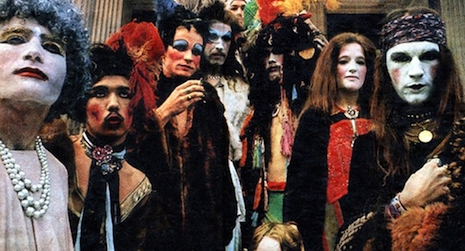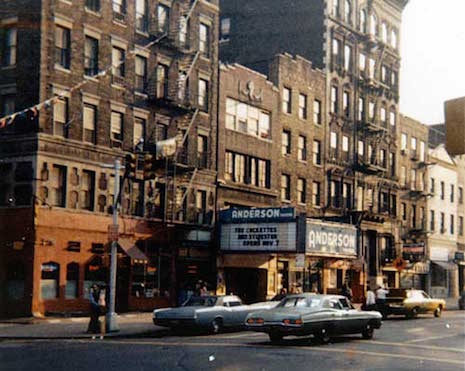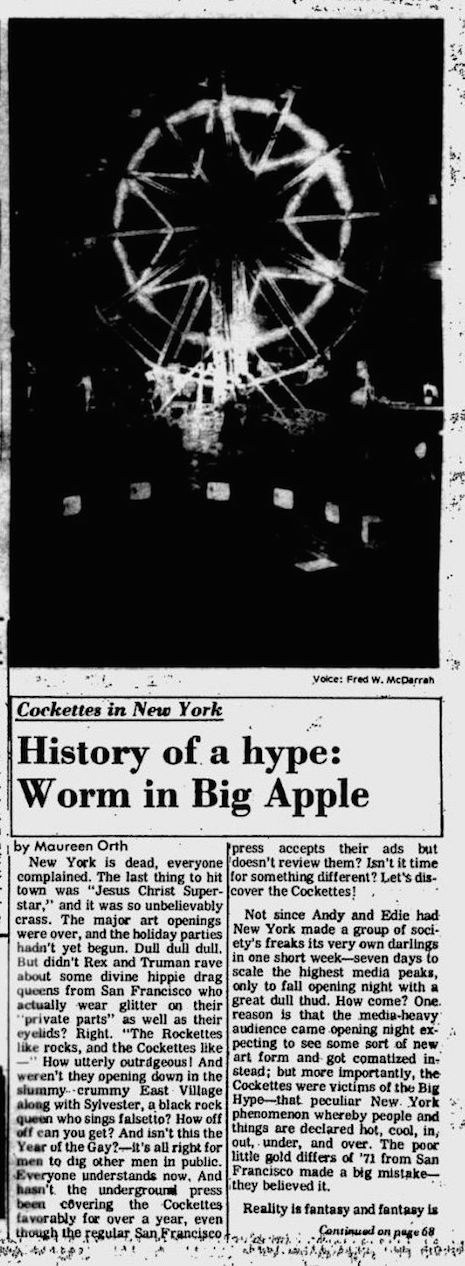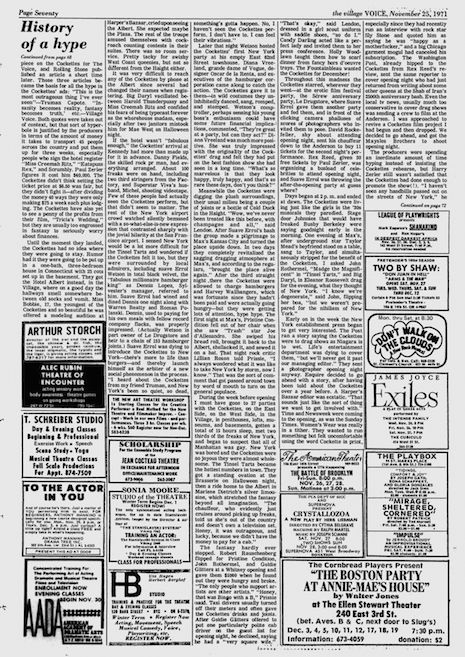
The Cockettes are a well-established part of post-Stonewall queer history as well as of the history of the San Francisco counterculture. By embracing their inner freaks, Hibiscus (a.k.a. George Harris) and his squad of burly, bearded, campy hippie drag queens were a de facto extension of Ken Kesey’s Merry Pranksters as well as perhaps a West Coast version of the scene that was coalescing around John Waters in Baltimore—little wonder that it didn’t take long for Divine and the Cockettes to appear on the same stages.
The narrative of a cult underground sensation blossoming into beloved crossover darlings actually never happened for the Cockettes—that narrative arc was interrupted by a disastrous month or so when they took their act from their native San Francisco to New York City, the place where all real sensations were (and to some extent still are) validated for widespread hipness and national cultural consumption. New York was dazzled and enthralled by the Cockettes for a week or two that happened to coincide with Halloween, but when they took their underground shtick to the cavernous confines of the Anderson Theater on Second Avenue between 3rd and 4th Streets, the allure, for the glitzy audience jammed with celebrities, burst like a soap bubble.
Getting information about the Cockettes’ catastrophic visit to New York isn’t the easiest thing in the world, but we are lucky to have access to one unparalleled contemporaneous source, a long analysis of the Cockettes’ trip by Maureen Orth that appeared in the November 25, 1971, issue of the Village Voice. (That lengthy article is available for you to read at the bottom of this post and is HIGHLY recommended for a fuller understanding of what happened to the Cockettes that week.) Unlike most of the disappointed reviewers who panned the Cockettes, Orth knew the troupe personally; she even traveled with them from San Francisco on a plane ride that must rank as one of the most bizarre in history, so she was in a position to see the disaster unfold with an unusually objective perspective, understanding the reasons that led to the letdown with some comprehension of both the seedy Bay Area values and the glitzier New York City logic. “Performance for the Cockettes is mostly an excuse to live a freaky life style,” Orth wrote, noting that the Cockettes, like the true freaks they were, were mostly broke-ass hairdressers or retail workers, unlike most of the better-heeled glitterati in New York City.
The Anderson was a strange venue for an act like the Cockettes. It was not a hip venue: In the 1950s it had been used as a Spanish-language theater, and in the 1960s its main programming was Yiddish-language fare. Hipper days were to come: In 1977 CBGB took it over and renamed it CBGB’s 2nd Avenue Theater, booking Talking Heads and Patti Smith, among others, but the experiment didn’t take: by 1979 it was no longer in use.

Difficult to make out, but the marquee reads, “The Cockettes and Sylvester, Opens Nov 7”
From 1969 to 1971, the Cockettes made a name for themselves with their ridiculous and campy shows, mostly held in a Chinese restaurant on Washington Square in North Beach called the Pagoda Palace Theater. The shows usually took place at midnight, which meant there was often an awkward encounter as patrons of the restaurant left, as throngs of drag queens collected on the sidewalk to begin their entertainment for the evening. Rex Reed and Truman Capote both saw the Cockettes in San Francisco, and both gushed about it—the imprimatur of two unchallenged camp authorities as Reed and Capote primed the pump for the disappointments to come.
A “San Francisco rock lawyer” by the name of Harry Zerler—he worked for Columbia Records but he had never produced a show before—sought to bring the Cockettes to New York, but he was likely a little bit in over his head; it might have been better if the Cockettes had used someone with more experience. But this point is inseparable from the basic problem of the Cockettes not fully understanding what they were getting into. Essentially, Zerler was seeking to parlay a shocking cross-dressing act into an overnight sensation based on two useful quotations from Capote (“This is the most outrageous thing I’ve ever seen”) and Reed (“Will the Cockettes replace rock concerts in the ‘70s?”) that were well-nigh made to appear in a newspaper ad.
It was some trouble finding a venue, but eventually The Cockettes were scheduled to kick off a run in New York City at the Anderson Theater in early November. Travel and lodging was expensive, given that the entire group numbered 45, including Sylvester plus entourage—Orth estimates Zerler’s outlay for the escapade at $40,000. When they landed at JFK, they actually didn’t know where they were going to stay in New York. There had been a rumor that they were going to have to sleep in cots in the basement of a house in Connecticut, but they ended up at the Hotel Albert on 23 East 10th Street; its reputation as a “rock and roll fleabag” probably makes staying there sound more fun than it actually was—as Orth observed, “On a good day the hallways smell somewhere between old socks and vomit.”
The story of the Cockettes’ time in New York City conforms satisfyingly to a rise and fall narrative. The Cockettes hit New York during Halloween season, and opening night was November 7. The show selected for opening night was a Cockettes standby called “Tinsel Tarts in a Hot Coma.” For the whole period leading up to the premiere, the Cockettes were the toast of the town. Orth writes: “During the week before opening I must have gone to 27 parties with the Cockettes, on the East Side, on the West Side, in the Village, in penthouses, lofts, museums, and basements, gotten a total of 15 hours of sleep, met two thirds of the freaks of New York, and began to suspect that all of Manhattan was gay.” In the aftermath of the opening night debacle, this series of parties, and the lack of rehearsal it implied, would loom large as a possible reason for the disappointing outcome. They somehow got access to Marlene Dietrich’s silver limousine to get around, but when they couldn’t use that, the “taxi drivers usually turned off their meters.” They hung out with Robert Rauschenberg and some of Warhol’s Factory hangers-on, and attended a SCREW magazine anniversary party.

Hibiscus
To say that New York was excited about the Cockettes is putting it mildly. Promoter Danny Fields was quoted as saying, “I haven’t seen such enthusiasm from the press since the Rolling Stones’ tour of the U.S. in 1969.” Opening night had sold out and the impossibility of securing a ticket became the talk of the town. The signs of impending disaster were there for those who cared to see it. The Cockettes, never very professional in the first place, were overtired and scattered from all the partying. The Cockettes had “barely rehearsed” and the sound system at the Anderson had not been installed until the very last minute.
So it was that an act that had made its name with trashy, scarcely rehearsed, low-rent, free-form parodies of decades-old cinema classics like Footlight Parade, Phantom of the Opera, and Busby Berkeley movies took to the stage of the Anderson Theater on November 7, 1971, in front of a sophisticated NYC audience bearing the highest expectations: “The Anderson was jammed. Hundreds of fashionables pushed and shoved their way through the one open door.” Orth supplies a partial list of the notable people present, as follows:
The [Women’s Wear Daily] photographer was beside himself. How could he shoot Gore Vidal, Allen Ginsberg, Angela Lansbury, Alexis Smith, Robert Rauschenberg, Rex Reed, Peggy Cass, Diana Vreeland, Nan Kemper, Clive Barnes, Sylvia Miles, Kay Thompson, Bobby Short, Elaine, Bill Blass, Estevez, Tony Perkins, Dan Greenburg, Nora Ephron, Mrs Sam Spiegel, Jerry Jorgensen, Ultra Violet, Candy Darling, Taylor Mead, Gerard Malanga, John Chamberlain, Cyrinda Fox, Holly Woodlawn, Jackie Curtis, the entire cast of “Jesus Christ Superstar,” the President of Gay Lib, a dozen Vogue editors, two real princesses, and the night clerk at the Hotel Albert?
The stage of the Anderson was far too big, which had the effect of unnecessarily diminishing the Cockettes’ threadbare stage sets. More to the point, devilish and campy goings-on undertaken by a bunch of down-and-out drag queens in an out-of-the-way San Francisco Chinese restaurant at midnight played very differently when placed under the bright lights of a New York theater.
The critical reception was harsh and unequivocal. Gore Vidal said, “Having no talent is not enough,” while Women’s Wear Daily simply pronounced it “dreadful.” The great Australian rock critic Lillian Roxon was one of the only figures to defend the Cockettes, in the pages of the Daily News, shrewdly noting that the troupe was fifteen years ahead of its time. That judgment may well have been correct.
Of the initial reception, Orth writes:
The audience came to get wrecked and thrilled by a fantastic new set of freaks. But as soon as the curtain went up it was all downhill. ... They loved Sylvester, even after 45 minutes, but the Cockettes were hopeless. The sound system was terrible, the show was too slow to crawl, and the Tinsel Tarts were even too tired to be themselves.
In his book The Fabulous Sylvester, Joshua Hamson summarizes the fallout thus:
New Yorkers do not suffer amateurs, or non-New Yorkers, gladly. What had seemed goofily, hippily charming to San Francisco—the Cockettes’ looseness, their inability to project their voices or use mikes properly, their tendency to run into sets and into each other—appeared to New Yorkers simply incompetent. “Whereas in San Francisco it had more of an event status, in New York it just seemed tacky,” says Rex Reed. “In San Francisco it all seemed wonderful and spontaneous and nutty. Here in New York it just seemed ridiculous, much ado about nothing.” Nor did the Cockettes’ happy-kids-on-drugs-expressing-whatever-comes-to-them vibe help them much. In New York, “happy, fun, and free” was often seen as the domain of the unhip, the dim, and the dull. Midway through, in what Ed McCormack called “an open an audible declaration that San Francisco drag queens just don’t make the grade by New York standard of decadence,” Taylor Mead of Andy Warhol’s Factory called out, as if invoking the name of God, “Where is Jackie Curtis?”
By the time the opening night show was over, those who had stayed to watch the whole thing filed out of the theater, as one observer put it, as if leaving a wake. “It’s three years old, and it’s boring,” a woman leaving the theater commented, and then corrected herself. “It’s five years old, and it’s boring. It’s no good just being a drag queen anymore. Anybody can do that.” Many had actually fled shortly after the show began. Rumors circulated that Angela Lansbury had stood up, said “Let’s get the fuck out of here,” and had taken a whole row with her. “My God,” said Rex Reed, whose column had made this bomb possible, “this is worse than Hiroshima.”
In 2009 a writer going by the name “produzentin” wrote an insightful summary of the trip for Laser Magazine. In the article the following list of reasons for the Cockettes’ NYC debacle is presented:
The troupe choose to perform the weak “Tinsel Tarts In A Hot Coma” on opening night;
Excessive partying didn’t leave time for rehearsals;
The stage of the Anderson Theatre was much bigger than in San Francisco and therefore the sets seemed lost;
The sound system was terrible;
It was a culture clash between New York and San Francisco mentalities and expectations.
In my opinion, it was this last factor that loomed largest, the difference between New York and San Francisco.
The Cockettes never did conquer the world, alas, and they are essentially not that much more than a footnote—albeit a very important one—in the development of queer culture. But it can easily be argued that the Cockettes’ way of engaging the world did conquer the world, just as Lillian Roxon predicted. By the 1990s John Waters had basically become America’s favorite queer uncle, and The Rocky Horror Picture Show, after a similarly rocky initial reception, has become a core part of our collective freaky curriculum.
Here’s Super-8 footage shot of Hibiscus and the Angels of Light (a Cockettes offshoot) in San Francisco’s North Beach:
Below, Maureen Orth’s lengthy account in the November 25, 1971, issue of the Village Voice. Click on the full-format pages for a larger, more readable version.




An advertisement in the Village Voice for the Cockettes’ New York City show:

Poster for the NYC show:

Previously on Dangerous Minds:
Children of Paradise: Life With The Cockettes
Fantastic posters for the Cockettes, Divine, Sylvester by Todd Trexler